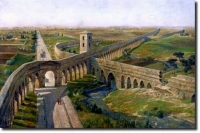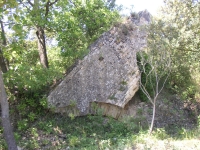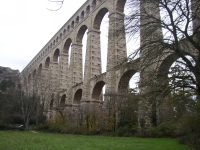



| Early history |
The later history of the aqueducts
At the time of the sack of Rome in 410 AD the eleven aqueducts were feeding 1212 public fountains, 11 imperial 'thermae' and 926 public baths (Morton, 1966:31). All trace of this achievement vanished during the barbarian invasions. Under Vitiges, the Goths cut the aqueducts in 537 AD. They probably were well acquainted with the utilities of the Romans by this time, as they had ruled much of Italy for the previous half century. By then, the Romans were a shadow of their former selves, and Vitiges actions diminished them further, forcing them to again take their water from wells and the Tiber. When Constantine moved the capital to Constantinople he took with him a host of patricians, artisans and professional men, to the detriment of Rome. The next two centuries became a cycle of neglect and decline, and depredations by Goths, Vandals and waves of Roman refugees. Morton (1966:56) estimates that perhaps 100 fountains were still working when Vitiges cut the water supply.Wartime use
Belisarius had taken Naples by sending men through an empty aqueduct. To prevent this happening again, he blocked many of Rome's channels with masonry. Nonetheless, an attempt was made. Procopius tells that a sentry saw the gleam of eyes and flicker of a torch in an aqueduct channel near the Pincian Gate. The Goths were prevented from further progress by one of the masonry walls. Belisarius sent a patrol into the aqueduct and discovered evidence that the Goths were scouting for an entrance into Rome. He kept the channel under close guard after this incident (Procopius, 6.9.1). The fact that the aqueduct could so easily be navigated suggests that little to no water flowed through it, perhaps as a result of Vitiges actions or neglect.One of the most notable of the Goths camps during their siege of Rome was located in the area south of Tor Fiscale in the area still known as Campo Barbarico. In his history of the Gothic wars, Procopius (7.3.3-7) describes the camp and the reason for its location among the aqueducts:
'Now there are two aqueducts between the Latin and Appian Ways, exceedingly high and carried on arches for a great distance. These two aqueducts meet at a place 50 stades distant from Rome and cross each other, so that for a little space they reverse their relative position. For the one which previously lay to the right from then on continues on the left side. And again coming together they resume their former places, and thereafter remain apart. Consequently the space between them, enclosed, as it is, by the aqueducts, comes to be a fortress. And the Barbarians walled up the lower arches here, with stones and mud and in this way gave it the form of a fort, and encamping there to the number of no fewer than seven thousand men, they kept guard that no provisions should thereafter be brought into the city by the enemy.The two aqueducts Procopius refers to are the Claudia and Marcia arcades that are found in that area. He is mistaken in his measurement of 50 stades, the truth is closer to 30, which is about 6 kilometres from Rome. The Goths remained in the camp for a little over a year, between February 537 and March 538, until pestilence forced them to abandon the siege.
Repair and continuity
One consequence of Vitiges cutting the aqueducts was to put the corn mills out of action. In response Belisarius mounted mills on rafts and moored them in the Tiber, and used the current to turn them. Vitages left without doing much more damage, but nine years later the Goth Totila captured Rome and evacuated the city. Rome may have been totally abandoned for forty days (Morton, 1966:57). After imperial victory, Belisarius repaired the aqueducts. Many of them continued to function until at least the 10th century. Only the Virgo continued to supply water into the middle ages. By the 14th century Rome and been reduced to 25,000 inhabitants. It would not be until the 16th century when a prosperous Rome would build a new aqueduct (Aicher, 1995:6).Restaurations
At the end of the 6th century Pope Gregory the Great refers to a 'comes formarum', indicating that the office of the 'curator', though now called a 'comes', still existed, as did the aqueducts, as often called in the middle ages 'formae'. By this time the city was poor, and little arrived in the way of patronage from Constantinople. The church took up the case of the aqueducts, unlike most of the other building and monuments, and the Popes continued to renovate them until the middle ages (Aicher, 1995:29).Pope Hadrian I carried out several restorations in the late 8th century. His restoration of the Traiana supplied the Trastevere region again, with its watermills on the Janiculum Hill. )1 St. Peter's Basilica also received this water, which played an important role in the religious life of the region.
No working aqueducts anymore
References to working aqueducts dwindle in the following centuries. While we have no dates to indicate when any of them ceased to function, we can be reasonably sure that by the end of the 10th century the people of Rome were again getting their water from wells and streams. The Traiana was repaired as late as the 9th century, but nothing more is heard of it until Pope Paul V incorporated parts of it into a new aqueduct in the 17th century. Both the Claudia and Anio Novus were out of commission by the 12th century, when an open-air ditch named the 'Marrana Mariana' was built to supply the Lateran region (Aicher, 1995:29).Like most of Rome's physical ruin, the process of losing water and sanitation was gradual. The agencies of destruction were invasion, erosion, earthquake and sedimentation, and the people lacked the will and resources for maintenance. Only the Virgo continued to function into the Middle Ages, however at a much reduced capacity (Aicher 1995:29).